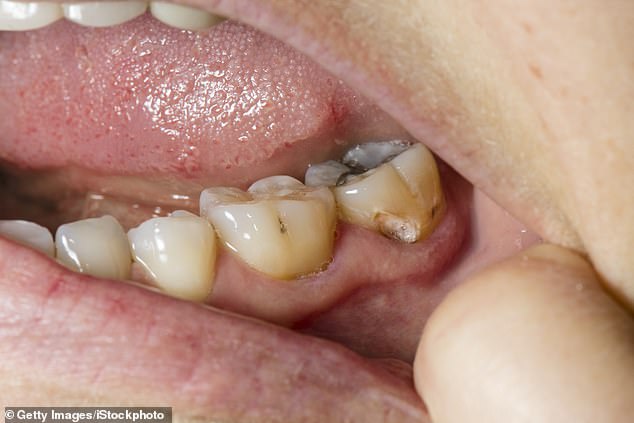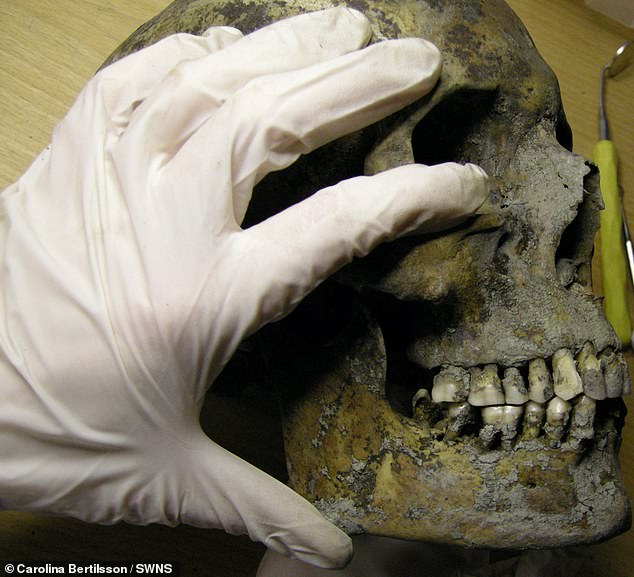Vikings suffered from acute toothache and were forced to pull out their own teeth to deal with the pain, analysis finds
It's been centuries since the Vikings swept through Europe amid an orgy of destruction and terror.
Although their worst excesses are difficult to excuse even after all these years, it appears that they suffered from particularly acute toothache at the time.
Perhaps because of their diet of beer, mead, honey and carbohydrates, it appears they had large cavities, leading to painful infections and abscesses.
Without access to fillings or root canals, there is also evidence that they attempted to 'drill' their own teeth, using tools to make holes. Many were even forced to pull teeth to cope with the pain.
The findings come from the analysis of more than 3,200 teeth from 171 Swedish Vikings buried in a cemetery between the 10th and 12th centuries.
It's been centuries since the Vikings swept through Europe amid an orgy of destruction and terror. Although their worst excesses are difficult to excuse even after all these years, it appears that they suffered from particularly acute toothache at the time (file image)

Perhaps because of their diet of beer, mead, honey and carbohydrates it appears they had large cavities, leading to painful infections and abscesses (file image)

Without access to fillings or root canals, there is also evidence that they attempted to 'drill' their own teeth, using tools to make holes. Many were even forced to pull teeth to cope with the pain (file image)
Researchers found that almost two-thirds of Viking adults had at least one cavity in their teeth.
In four percent of teeth, this had caused an infection to reach the nerve, and possibly an abscess, causing the kind of pain that today a root canal would treat.
But the resourceful marauding Vikings seem to have realized, even without dental drills, that they could make a hole in the tooth to relieve pressure and allow the pus from the infection to escape.
These holes were found in the teeth of two people in the cemetery near a Christian church in Varnhem, Sweden.
Dr. Carolina Bertilsson, who led the research at the University of Gothenburg in Sweden, said: 'Many Vikings may have been in a very bad mood due to unbearable toothache.
'When something hurts so bad, you want it to stop. Perhaps this is how they came into contact with early forms of dentistry and, it seems, sometimes pulled out their own teeth out of desperation.
'Without local anesthesia that must have been really terrible, so maybe we should feel a little sorry for them.'
The study, published in the journal PLOS One, involved dentists who closely examined the teeth of 87 men and 46 women from Sweden's Viking population who died at an average age of 35, and 38 children aged from babies to 12 years .
Of the 171 Vikings, 83 adults were found to have holes in their teeth, caused by tooth decay.

Researchers found that almost two-thirds of Viking adults had at least one cavity in their teeth (Photo: A researcher examining a Viking's jaw and teeth)

In four percent of teeth this had caused an infection that reached the nerve, and possibly an abscess, causing the kind of pain that would today be treated with a root canal (file image)

Previous research has found that three percent of Vikings who invaded Scotland had similar cavities that could have caused extreme pain if they reached the nerve in the tooth (file image)
Previous research has found that three percent of Vikings who invaded Scotland had similar cavities that could have caused extreme pain if they reached the nerve in the tooth.
About five percent of the teeth the Vikings should have had were lost before death, with researchers believing many teeth were pulled out in frustration with toothache.
Dr. Bertillson said: 'Vikings ate very starchy foods such as bread and porridge, which was bad for their teeth, and the water was not suitable for drinking, so they drank beer, which contributes to tooth decay, as does mead.
“They also used honey to sweeten food and ate fruit, which always gave them cavities.”
The study also found evidence that a male Viking filed horizontal grooves in his front teeth, which has been seen before and may have been a sign of status, and was done before going to war.
The Vikings may not have had toothbrushes, but they appear to have been conscious of dental hygiene, with marks on the teeth showing that they had used toothpicks, similar to modern dental floss, to remove food from between their teeth.
An abscess found in a female Viking may have killed her in her early 30s, the researchers suggest, because it was bad enough that the infection may have caused sepsis, or swelling, that blocked her airways and stopped her breathing.
Overbites and crowded mouths were less common among Vikings, perhaps because their mandibles enlarged to consume the harder, coarser foods that were part of their diet.
The researchers found that 29 percent of the Vikings whose teeth were analyzed had dental infections.
